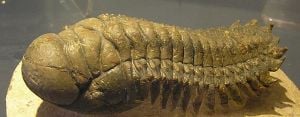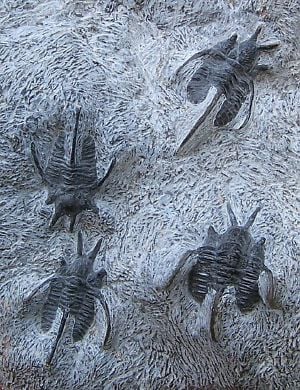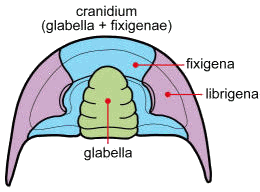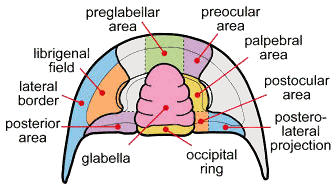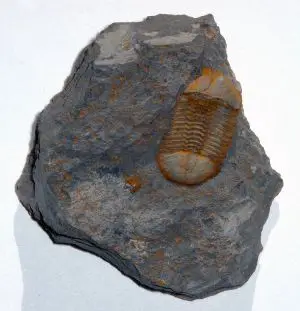Difference between revisions of "Trilobite" - New World Encyclopedia
m (Robot: Remove contracted tag) |
m (Remove * from 'optional' links) |
||
| Line 5: | Line 5: | ||
{{Taxobox_regnum_entry | taxon = [[Animal]]ia}} | {{Taxobox_regnum_entry | taxon = [[Animal]]ia}} | ||
{{Taxobox_phylum_entry | taxon = [[Arthropod]]a}} | {{Taxobox_phylum_entry | taxon = [[Arthropod]]a}} | ||
| − | {{Taxobox_classis_entry | taxon = '''Trilobita'''}}<br/>{{Taxobox authority | author = [[Johann Ernst Immanuel Walch|Walch]] | + | {{Taxobox_classis_entry | taxon = '''Trilobita'''}}<br/>{{Taxobox authority | author = [[Johann Ernst Immanuel Walch|Walch]] | date = 1771}} |
{{Taxobox_end_placement}} | {{Taxobox_end_placement}} | ||
{{Taxobox_section_subdivision | color = pink | plural_taxon = Orders}} | {{Taxobox_section_subdivision | color = pink | plural_taxon = Orders}} | ||
Revision as of 15:55, 29 August 2008
| Trilobite Fossil range: Cambrian-Permian | ||||||
|---|---|---|---|---|---|---|
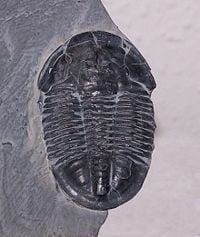 Asaphiscus wheeleri, a trilobite from Cambrian-age shale in Utah | ||||||
| Scientific classification | ||||||
| ||||||
| Orders | ||||||
|
Trilobites are extinct arthropods in the class Trilobita. They appeared in the Cambrian period, about 540 million years ago (mya) and flourished throughout the lower Paleozoic era before slowly declining to extinction. The last of the trilobites disappeared in the mass extinction event at the end of the Permian, 250 mya.
Trilobites are very well known, and possibly the second-most famous fossil group after the dinosaurs. They are the most diverse group of animal species preserved in the fossil record, consisting of nine (or possibly ten) orders and over 15,000 species. The trilobites are considered to be the first animals to evolve true eyes.
Trilobites represent an earlier stage in the step-by-step development of life on Earth. Chaisson (2005) notes, "though all trilobites have been extinct for the past 200 million years, paleobiologists are reasonably sure that some version of them gave rise to most of today’s animals."
Most were simple, small marine creatures that walked along the sea floor and are thought to have filtered mud to obtain food.
| Paleozoic era (542 - 251 mya) | |||||
|---|---|---|---|---|---|
| Cambrian | Ordovician | Silurian | Devonian | Carboniferous | Permian |
Physical description
The bodies of trilobites are divided into three parts (tagmata): a cephalon (head), composed of the two preoral and first four postoral segments completely fused together; a thorax composed of freely articulating segments; and a pygidium (tail) composed of the last few segments fused together with the telson (last division of the body). The pygidia are still fairly rudimentary in the most primitive trilobites. The thorax is fairly flexible—fossilized trilobites are often found curled up like modern woodlice, perhaps for protection.
Trilobites had a single pair of preoral antennae and otherwise undifferentiated biramous (double-branched) limbs. Each exopodite (walking leg) had six segments, analogous to those of other early arthropods. The first segment also bore a feather-like epipodite, or gill branch, which is considered to have been used for respiration and swimming. The limbs were covered by lateral projections called "pleural lobes," extending outward from a central "axial lobe." Contrary to popular belief, it is this longitudinal tripartite division into left and right pleural lobes and a central axial lobe that gives trilobites their name, not the division into cephalon, thorax, and pygidium.
Although trilobites were only armored on top, they still had a fairly heavy exoskeleton, composed of calcite and calcium phosphate minerals in a protein lattice of chitin. Unlike other groups of armored arthropods, which resorb most of their skeletal minerals prior to molting, a trilobite would cast off a fully mineralized molt. Thus, a single trilobite animal could potentially have left multiple well-mineralized skeletons behind—further enhancing the apparent abundance of trilobites in the fossil record.
During molting, the exoskeleton generally split between the head and thorax, which is why so many trilobite fossils are missing one or the other: Many trilobite fossils are actually molted exoskeletons rather than dead trilobites. In most groups, there were two facial sutures on the cephalon to make shedding easier. The cheeks of the cephalon usually also supported a pair of crescent-shaped compound eyes, which were surprisingly advanced in some species. In fact, trilobites are considered to be the first animals to evolve true eyes, about 543 million years ago; the evolutionary appearance of eyes has been postulated as a trigger for the Cambrian Explosion.
Some trilobites, such as those of the order Lichida, evolved elaborate spiny forms from the Ordovician until the end of the Devonian period. Examples of these specimens have been found in the Hamar Laghdad formation of Alnif in Morocco. Collectors of this material should be aware of a serious counterfeiting problem with much of the Moroccan material that is offered commercially. Spectacular spined trilobites have also been found in western Russia; Oklahoma, U.S.; and Ontario, Canada. These spiny forms could possibly have been a defensive response to the evolutionary appearance of fish.
According to New Scientist magazine (May 2005), "some… trilobites… had horns on their heads similar to those of modern beetles." Based on the size, location, and shape of the horns, Rob Knell, a biologist at Queen Mary, University of London and Richard Fortey of London's Natural History Museum, concluded that the most likely use of the horns was combat for mates, making trilobites the earliest exemplars of this behavior. While this study only covered the raphiophorid family, the conclusions can be applied to other groups as well, such as the tridentate phacopide trilobite Walliserops trifurcatus.
Trilobites range in length from one millimeter to 72 cm (1/25 inch to 28 inches), with a typical size range of two to seven centimeters (1 to 3½ inches). The world's largest trilobite, Isotelus rex, was found in 1998, by Canadian scientists in Ordovician rocks on the shores of Hudson Bay.
Sensory organs
Many trilobites had eyes. Some trilobites were blind, probably living too deep in the sea for light to reach them. Others, such as hacops rana, had eyes that were quite large. Trilobites also had antennae that perhaps were used for taste and smell.
The eyes of trilobites were made of calcite (calcium carbonate, CaCO3). Pure forms of calcite are transparent, and some trilobites used a single crystallographically oriented, clear calcite crystal to form the lens of each of their eyes. In this, they differ from most other arthropods, which have soft or chitin-supported eyes. The rigid calcite lenses of a trilobite eye would have been unable to accommodate to a change of focus, like the soft lens in a human eye would. However, in some trilobites, the calcite formed an internal doublet structure, apparently giving superb depth of field and minimal spherical aberration, as discovered by Dutch physicist Christiaan Huygens. A living species with similar lenses is the brittle star Ophiocoma wendtii, an echinoderm.
The trilobite eyes were typically compound, with each lens being an elongated prism. The number of lenses in such an eye varied, however: Some trilobites had only one, and some had thousands of lenses in a single eye. In these compound eyes, the lenses were typically arranged hexagonally.
Holochroal eyes
Holochroal eyes had a great number of (tiny) lenses (sometimes over 15,000), and are found in all orders of trilobite. These lenses were packed closely together (hexagonally) and touch each other. A single corneal membrane covered all lenses. These eyes had no sclera, the white layer covering the eyes of most modern arthropods.
Schizochroal eyes
Schizochroal eyes typically had fewer (and larger) lenses (to around 700), and are found only in Phacopida. The lenses were separate, with each lens having an individual cornea which extended into a rather large sclera.
Abathochroal eyes
Abathochroal eyes had few (and small) lenses (to around 70), and are found only in Cambrian Eodiscina. Each lens was separate and had an individual cornea. The sclera was separate from the cornea, and did not run as deep as the sclera in schizochroal eyes.
Development
From the fossil record, the following trilobite life cycle has been reconstructed. An egg hatched to give a tiny larva called a "protaspid," in which all segments are fused into a single carapace. Subsequent thoracic segments were added just ahead of the pygidium ("pygidial release") in successive molts during an intermediate stage called "meraspid." Finally, the adult number of segments was reached, at which point the animal is called a "holaspid."
In many species, molting continued during the holaspid stage with no changes in segment number. Trilobite larvae are reasonably well known and provide an important aid in evaluating high-level phylogenetic relationships among trilobites.
Terminology
When describing differences between different taxa of trilobites, the presence, size, and shape of the cephalic features are often mentioned.
Figure 1 shows gross morphology of the cephalon. The cheeks (genae) are the pleural lobes on each side of the axial feature, the glabella. When trilobites molted or died, the librigenae (the so-called "free cheeks") often separated, leaving the cranidium (glabella + fixigenae) exposed. Figure 2 shows a more detailed view of the cephalon.
Origins and extinction
Based on morphological similarities, it is possible that the trilobites have their ancestors in arthropod-like creatures such as Spriggina, Parvancorina, and other trilobitomorphs of the Ediacaran period of the Precambrian. There are many morphological similarities between early trilobites and other Cambrian arthropods known from the Burgess Shale and other fossiliferous locations. It is reasonable to assume that the trilobites share a common ancestor with these other arthropods prior to the Ediacaran-Cambrian boundary.
The exact reason for the extinction of the trilobites is not clear, although it would seem to be no coincidence that their numbers began to decrease with the arrival of the first sharks and other early fish in the Silurian and Devonian periods with their strong, hinged jaw. Trilobites may have provided a rich source of food for these new arrivals.
Additionally, their relatively low numbers and diversity at the end of the Permian no doubt contributed to their extinction during that great mass extinction event. Foreshadowing this, the Ordovician mass extinction, though somewhat less substantial than the Permian one, also seems to have significantly narrowed trilobite diversity.
The closest extant (living) relatives of trilobites may be the cephalocarids, minute marine crustaceans. (Lambert 1985). Horseshoe crabs also are considered to be a close present-day relative.
Fossil distribution
Trilobites appear to have been exclusively marine organisms, since the fossilized remains of trilobites are always found in rocks containing fossils of other salt-water animals, such as brachiopods, crinoids, and corals. Within the marine paleoenvironment, trilobites were found in a broad range, from extremely shallow water to very deep water. The tracks left behind by trilobites crawling on the sea floor are occasionally preserved as trace fossils. Trilobites, like brachiopods, crinoids, and corals, are found on all modern continents, and occupied every ancient ocean from which fossils have been collected.
Trilobite fossils are found worldwide, with many thousands of known species. Because they evolved rapidly, trilobites serve as excellent index fossils, enabling geologists to date the age of the rocks in which they are found. They were among the first fossils to attract widespread attention, and new species are being discovered every year. Some Native Americans, recognizing that trilobites were water creatures, had a name for them which means "little water bug in the rocks."
A famous location for trilobite fossils in the United Kingdom is Wren's Nest, Dudley in the West Midlands, where Calymene blumenbachi is found in the Silurian Wenlock Group Limestone formation. This trilobite is featured on the town's coat of arms and was named the "Dudley locust" or "Dudley bug" by quarrymen who once worked many of the now abandoned limestone quarries. Other trilobites found there include Dalmanites, Trimerus, and Bumastus.
Spectacular trilobite fossils, showing soft body parts like legs, gills, and antennae, have been found in British Columbia (Burgess Shale Cambrian fossils, and similar localities in the Canadian Rockies); New York State (Odovician Walcott-Rust Quarry, near Utica, N.Y., and the Beecher Trilobite Beds, near Rome, N.Y.), in China (Burgess Shale-like Lower Cambrian trilobites in the Maotianshan shales near Chengjiang), Germany (the Devonian Hunsrück Slates near Bundenbach, Germany) and, much more rarely, in trilobite-bearing strata in Utah and Ontario.
Trilobites are collected commercially in Russia (especially in the St. Petersburg area), Germany, Morocco's Atlas Mountains, Utah, Ohio, British Columbia, and in other parts of Canada.
ReferencesISBN links support NWE through referral fees
- Chaisson, E. J. 2005. Recent fossils]. Cosmic Evolution Website, Tufts University. Retrieved December 20, 2006.
- Fortey, R. 2000. Trilobite! Eyewitness to Evolution. London: Harper Collins. ISBN 0-00-257012-2
- Knill, R. and R. Fortney. Earliest combatants in sexual contests revealed in New Scientist 2501 (May 2005):16. Retrieved December 21, 2006.
- Lambert, D., and the Diagram Group. 1985. The Field Guide to Prehistoric Life. New York: Facts on File Publications. ISBN 0-8160-1125-7
- Levi-Setti, R. 1993. Trilobites. University of Chicago Press. ISBN 0226474526
External links
- Western Trilobite Association. Retrieved September 24, 2007.
- Kevin's Trilobite Gallery—a collection of photographs of trilobite fossils. Retrieved September 24, 2007.
- Mark Bourrie's trilobite collection—another collection of photographs of trilobite fossils. Retrieved September 24, 2007.
- A Guide to the Orders of Trilobites. Retrieved September 24, 2007.
Credits
New World Encyclopedia writers and editors rewrote and completed the Wikipedia article in accordance with New World Encyclopedia standards. This article abides by terms of the Creative Commons CC-by-sa 3.0 License (CC-by-sa), which may be used and disseminated with proper attribution. Credit is due under the terms of this license that can reference both the New World Encyclopedia contributors and the selfless volunteer contributors of the Wikimedia Foundation. To cite this article click here for a list of acceptable citing formats.The history of earlier contributions by wikipedians is accessible to researchers here:
The history of this article since it was imported to New World Encyclopedia:
Note: Some restrictions may apply to use of individual images which are separately licensed.


